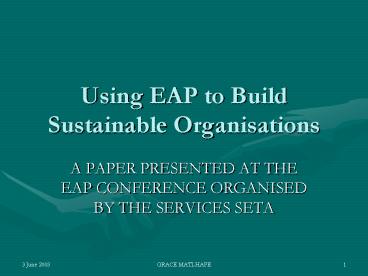Using EAP to Build Sustainable Organisations - PowerPoint PPT Presentation
1 / 24
Title:
Using EAP to Build Sustainable Organisations
Description:
LEADERSHIP. Leaders who vision, align, empower, coach, and care ... in focus, and develop a preventative and facilitative role more boldly ... – PowerPoint PPT presentation
Number of Views:24
Avg rating:3.0/5.0
Title: Using EAP to Build Sustainable Organisations
1
Using EAP to Build Sustainable Organisations
- A PAPER PRESENTED AT THE EAP CONFERENCE ORGANISED
BY THE SERVICES SETA
2
Assumptions
- Basic understanding of EAP and EAP operations
- No need to define
- Benefits of EAP operations are clear and
undisputed. - This presentation focuses on strengthening and
value adding benefits
3
What makes Organisations Sustainable?
- Vision
- Knowing when it is time to identify and establish
new goals - Leadership
- To rally resources, human and material, towards a
common goal - People
- To make it all happen
4
Vision
- Identifying a strategic advantage and leveraging
it to create a long term favorable position in
the eyes of the customer - Knowing where you want to go, and using every
transaction to ensure that you get there - Ensuring that you never arrive where you are
going
5
Elements of Sustainability
- CUSTOMER FOCUS
- CONSISTENT EMPLOYEE PERFORMANCE
- VISIONARY LEADERSHIP
- CONTINUOUS IMPROVEMENT
6
CUSTOMER FOCUS
- Consistently meeting a customers expectations
- Excellence of product as well as service offering
- Understanding value from a customers perspective
- Customer as a partner rather than a target
- Preempting changing customer needs
7
CONTINUOUS IMPROVEMENT
- Quality is not about being perfect, it is about
getting better - Continuous improvement not only of systems and
processes, but of the organisation as a whole - Growth through innovation and creativity
- Turning customer satisfaction into customer
delight
8
CONTINUOUS IMPROVEMENT
9
LEADERSHIP
- Leaders who vision, align, empower, coach, and
care - In order to steer organisations through the many
modern day changes and challenges, leaders today
have to be more concerned about others, flexible,
adaptable, innovative and more thoughtful and
responsive - Leader as master and leader as colleague
- Service to Customers and to Employees
10
Employee Participation
- The most popular misconception is that the whole
economic structure revolves around money. What
is missed in these arguments is that markets are
made up of people, and that the transactional
base of society is in fact of people serving
people - Ceronio 1996
11
Employee Performance
- The main vehicle for achieving customer
satisfaction is the external value created by
satisfied employees - People are what distinguishes good organisations
from great organisations- people set
organisations alight - People are the only resource that shareholders
cannot really own
12
Using EAP to Build Sustainable Organisations
- What has all this got to do with EAP?
13
Using EAP to Build Sustainable Organisations
- EAP services are a component of the workplace
because of the key role they play in enhancing
productivity and improving profitability
14
THE SERVICE RELATIONSHIP TRIANGLE Heskett et al
1997
Service Organisation
EAP
Customer support to organisation
Organisation support to employees
customer
Employee
Employee support to customer
15
Employee Related Challenges in SA
- Diversity management
- Skills development
- Employee Wellbeing
- Short service tenure
- Crime
Employee Assistance Programmes
16
Using EAP to Build Sustainable Organisations
- An organisations strategy consists of the
actions and business approaches management
employs to achieve targeted organisational
performance
17
The Role of EAP in enhancing business success
- Can contribute insights into the management of
people - If properly integrated into all business
processes, EAP have potential to make a
difference at the strategic level of
organisations - Can facilitate the transformation of
organisations towards people oriented systems to
enhance insight into employees and customers as
people
18
The Role of EAP in enhancing business success
- Management of softer issues
- Important management time dedicated to real
management issues while softer issues are
delegated to junior management - Because employees are organisations, the
wellbeing of employees has to be a business
priority
19
The Role of EAP in enhancing business success
- Facilitating customer focus
- Enhancing continuous improvement
- Encouraging and strengthening employee
participation - Strengthening service oriented styles of
leadership
20
Conclusions
- Inadequate understanding of EAP in SA
organisations - This results in inadequate sensitivity to
employees problems, whether work related or
unrelated - The responsibility rests with both EAP
professionals and management to change this
status quo
21
Conclusions
- Productivity must be seen as a strategic issue
for South African companies. This paradigm
change will facilitate the use of productivity
enhancing strategies like EAP strategically - EAP must stop being used as a nice to have.
Companies use of EAP should be based on an
informed set of expectations with a direct impact
on the strategic objectives of the company.
22
Conclusions
- EAP can be used to achieve the organization's
optimal utilization of all its factors of
production. - EAP systems have to stop being only reactionary
in focus, and develop a preventative and
facilitative role more boldly
23
Conclusions
- There is a need for EAP professionals to be more
aware of the forces of competition affecting the
company. This awareness will facilitate their
ability to support the company and its employees
in a manner that really matters to the companys
bottom line
24
Conclusions
- EAP is the central function within the
organisation that has the potential to close the
service-profit chain































